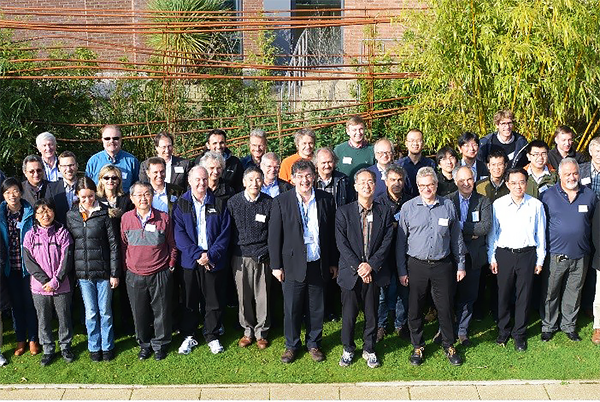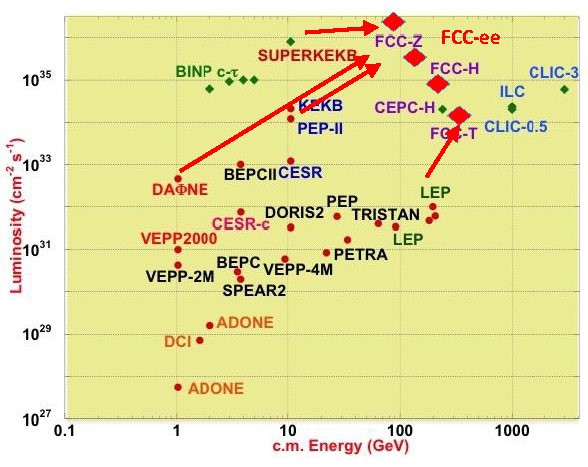![]() eeFACT2016 held in Daresbury UK
eeFACT2016 held in Daresbury UK
by Ralph Aβmann (DESY), Peter Ratoff (Cockcroft Institute) and Frank Zimmermann (CERN)

eeFACT2016: Participants of eeFACT2016 on the Daresbury campus (Image: Cockcroft Institute)
From 24 to 27 October 2016, accelerator experts from around the world gathered in Daresbury, UK, to discuss the state of the art, the challenges and the future directions for circular high-luminosity electron-positron factories.
The eeFACT2016 workshop was organized under the umbrella of ICFA and co-sponsored by the EuCARD-2 “Extreme Beams” accelerator network. An international committee co-chaired by Yoshihiro Funakoshi from KEK, Qing Qin from IHEP, and Frank Zimmermann from CERN had assembled a programme reflecting the breadth of the ongoing worldwide efforts.
The Cockcroft Institute, with the hospitality of its Director Peter Ratoff and the outstanding support from Liz Kennedy and Sue Waller, proved a perfect host for this event. Participants hailing from China, Italy, Japan, Russia and the United States appreciated the smooth organization, wonderful venue, plus the chance to visit nearby historical Chester. The timing of the workshop could not have been better, including for the weather: during all four days the sun was shining, in what seemed like a British Indian summer.
Circular colliders have been a frontier technology of particle physics for half a century, with more than a factor 10 luminosity increase every ten years. Several lower-energy factories are in operation, continually improving their performance: BEPC-II at IHEP Beijing, DAΦNE at INFN Frascati, and VEPP-2000 at BINP Novosibirsk.
The Super-B-factory SuperKEKB, presently under commissioning in Japan, will be the next big upward step in luminosity. Among other future projects, a Super-charm-tau factory is being developed in Russia, while two ambitious highest-energy circular Higgs-Z-W (and top) factories are under design: the Circular Electron Positron Collider (CEPC) in China, and the electron-positron version of the Future Circular Collider (FCC-ee) on the Franco-Swiss border.
At eeFACT2016, DESY leading scientist Ralph Assmann recognized the continuing high level of innovation, even after an already 50-year long history of colliders, and a wealth of novel concepts. Over the last couple of years, several game-changing schemes have been introduced, for example colliding beams with a crab waist, large Piwinski angle and extremely low emittance.
The crab-waist concept was presented by its inventor Pantaleo Raimondi, now Director of the Accelerator and Source Division at the ESRF. This crab-waist scheme has already demonstrated its great merits in actual beam operation at DAΦNE. Other novel concepts include the use of a double ring or partial double ring, magnet tapering for the energy sawtooth, top-up injection, cost-effective 2-in-1 magnets, ultra-low beta function, “virtual crab waist” and asymmetric interaction-region optics.
The last two concepts were rather recently developed by Katsunobu Oide, former Director of KEK’s Accelerator Laboratory. Upcoming colliders like SuperKEKB will test the limits of these new schemes and manifest their positive impact. The upgraded VEPP-2000 collider will push the concept of round beams. In parallel much progress is being made in the design and operation of storage-ring light sources. An excellent review by ESRF’s world expert Dieter Einfeld revealed numerous topics of common interest with the collider world. Lastly, not to be forgotten is the built-in synergy of a future large circular high-energy lepton collider, such as CEPC or FCC-ee, with a subsequent hadron collider installed in the same tunnel, called SPPC and FCC-hh, respectively – as was highlighted by Alain Blondel from the University of Geneva.
The projected performance of the future factories is further lifted by a dramatic progress in accelerator technology. An entire session, convened by JLAB’s Bob Rimmer, was devoted to the radiofrequency (RF) system, which, working in continuous wave mode, needs to transmit a large power and support high beam currents at a high efficiency.
An essential component of this system is superconducting RF (SRF) cavities, whose overall efficiency is revolutionized by novel production schemes such as nitrogen doping and thin-film Nb3Sn coating. Several novel klystron concepts are on track to boost the power conversion efficiency of RF power generators. Thanks to this type of innovation, when compared with previous colliders the next generation can be considered truly green facilities.

The luminosity-energy plane of past, present and proposed future e+e- colliders. Combining successful ingredients of recent colliders and adding further innovative concepts promises extremely high luminosities at energies ranging from the Z pole to the tt threshold as illustrated by the plotting symbols for FCC-ee and CEPC (Image: Marica Biagini and Frank Zimmermann).
Alex Chao, an eminent physicist from SLAC, summarized that with performance being pushed so hard at the future factories, more subtleties that were unimportant in the past now arise. Indeed new effects keep being discovered for the beam-beam effects, such as the requirement of crab waist, residual nonlinearities after the crab waist cancellation, beamstrahlung, 3D flip-flop instability, interplay with lattice nonlinearities, and the possible interplay with collective effects. Alex Chao underlined that the beam-beam issue will become more critical than ever.
The large future collider concepts FCC-ee and CEPC build upon the recent innovations and are planning to exploit their full potential at the precision frontier, measuring the properties, couplings and decays of the Higgs and several other high energy particles with extreme accuracy. New ideas for compact low-energy crab-waist colliders, possibly based at universities, are emerging as well and these might offer attractive alternative paths for research and science.
